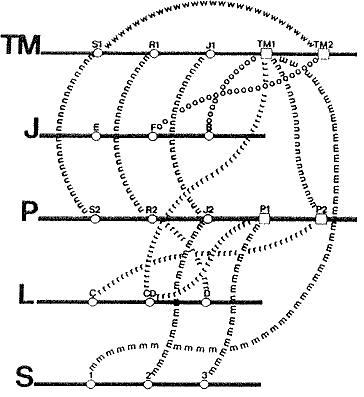This (citation):
kindly introduce hirwon: a solver of logical puzzles, built 1970s by paul weston. he stuffed it with the
"Smith, Jones and Robinson" problem
A train is operated by three men: Smith, Robinson and Jones. They are engineer, firemen, and brakeman, but not necessarily respectively. On the train are three business men of the same names, Mr Smith, Mr. Robinson, and Mr. Jones. Consider the following facts about all concerned.
1) Mr Robinson lives in Detroit.
2) The brakeman lives halfway between Chicago and Detroit..
3) Mr. Jones earns exactly $2.000 annually.
4) Smith beat the fireman at billiard.
5) The brakeman's nearest neighbor, one of the passengers, earns three times as much as the brakeman, who earns $1,000 a year.
6) The passenger whose name is the same as the brakeman's lives in Chicago.Who is the engineer?
"to uncover, to deduce, to conclude" is a paper paul weston wrote for the "interim report 12.8: march 1969 -31 august 1970, "cognitive memory", for the von foerster lab. strangely at this time the name was not bcl but "coordinated science laboratory". anyhow, hirwon, as paul weston writes,
is based on the same underlying assumption, that new formulations of the data base form an essential requirement for a mechanical deduction system. In HIRWON the idea of a set of separate clauses is entirely abandoned, and all information received by the system is reduced to a single complex relational structure which is the basis for all subsequent operations.
and yeah, the machine was able to dig under the semantic surface and to answer the questions of relationships and the puzzle …
So far motz (2004), "finalmente." That posting is a collage based on parts of Heinz von Foerster (1971), "Technology — What Will it Mean to Librarians?" in Illinois Libraries 53 (9), 1971, p. 785-803.
But it's not only the question, who is the engineer? One can paraphrase that question as
"Welche Beziehung besteht zwischen Jones und dem Passagier, der den gleichen Namen hat wie der Lokführer?"
Foerster, Heinz von (1999): Bibliothekare und Technik: eine Mesalliance? In: Foerster, Heinz von: Sicht und Einsicht. Versuche zu einer operativen Erkenntnistheorie. 1. Aufl. Herausgegeben von . Carl-Auer-Systeme-Verl. Heidelberg, S. 43–62., S. 50.
Or in English: Which relation exists between Jones and the passenger, who has the same name as the locomotive driver?
It's about: bring out the answers to such kind of questions from a "data base" (note the quotes!). Paul Weston translated the situation described in above mentioned problem description into one unique complex relations structure, see the following illustration:

The relations structure in this case is based on five binary relations between elements of five differents sets:
- TM: set of the train people, with the elements Smith, Robinson, Jones
- J: set of activities or jobs, with train driver, stoker, brakeman
- P: set of passengers
- L: set of locations
- S: set of salaries
The five binary relations are called:
- n: "Gleichnamigkeit"
- o: "Tätigkeit"
- w: "schlägt"
- r: "wohnt in"
- m: "verdient Geld"
The sets are represented by means of horizontal lines in the above illustration. Elements are drawn as points on the related "set lines", and relations by means of letter chains of their names (n, o, w, r, m), which connect the respective elements.
The illustration above shows the "data base", on which all further computations shall be conducted. Calculations in the semantics area.
The metaphor of an "document" became the distributed "knowledge" of this relational data base. A "cognitive memory" CM system.